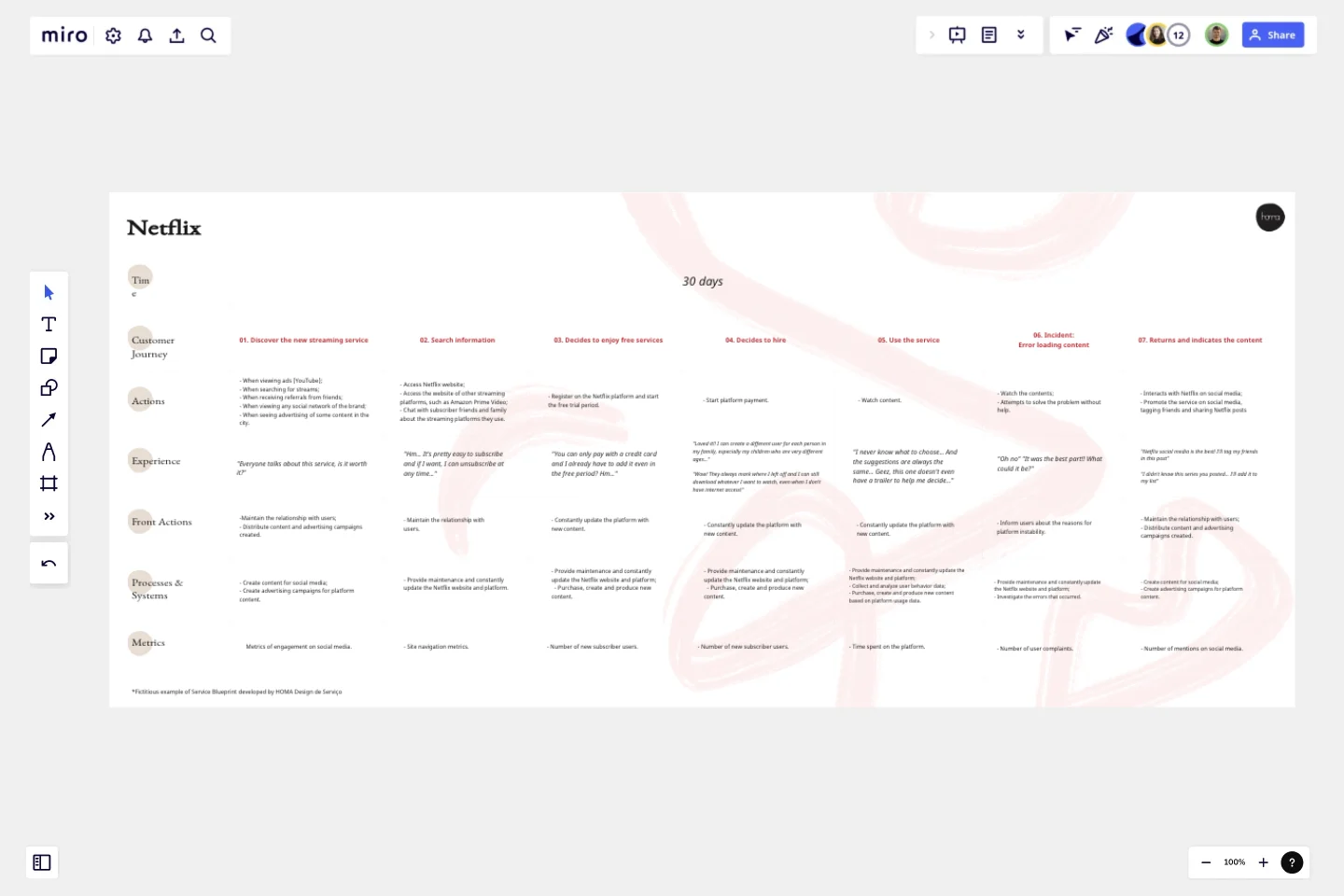Service Blueprint by Bruna Plentz
Service Blueprint template created by HOMA Service Design Consultancy for innovation and management of customer experience.
The service blueprint is widely used to highlight the reality of companies, to identify opportunities for innovation and service improvements. This tool is quite interesting to explore all the steps of creating and managing a service. With it, it is possible to visualize all the phases of the customer journey, their actions and reactions, in addition to what happens in internal processes.
To use this template, follow these steps:
Assemble your team to fill it out collaboratively. Don't forget to invite people who have direct contact with your customer, they are an excellent source of knowledge!
Map the moments of the customer journey... Include everything from the moments when customers are just considering your service to the post-service phase, that is, the relationship stage;
Then fill in the actions, experiences, and processes that your team knows about;
For the blueprint to be more reliable, conduct qualitative research to understand in more depth the behaviour of customers;5. Finally, fill in the metrics for your company to track the customer experience at every moment of the journey.
This template was created by Bruna Plentz.
Get started with this template right now.
Heuristic Evaluation Template
Works best for:
Design
The Heuristic Evaluation Template is a valuable tool in UX design. It relies on heuristics to identify usability issues and opportunities for improvement. Similarly, design heuristics serve as guidelines to evaluate the quality of a design solution. Following ten principles of good design can enhance the effectiveness of a product or service. Use these guidelines to evaluate your work and enhance the user experience of your design solutions.
Service Blueprint Workshop
Works best for:
Research & Design
The Service Blueprint Workshop by Lidia Olszewska is designed for collaborative service design sessions. This template helps teams visualize service processes, identify pain points, and brainstorm solutions. Use it to align cross-functional teams, improve service delivery, and ensure a seamless customer experience. It's ideal for workshops aimed at service optimization, fostering collaboration, and strategic planning in service design.
Empathy Map Canvas by Sampriti Jain
Works best for:
Market Research, Strategy & Planning
The Empathy Map Canvas template allows you to explore user behaviors and emotions comprehensively. It’s designed to help you visualize user experiences and create solutions that truly meet their needs. Perfect for UX teams and product developers.
E-Commerce Wireframe Template
Works best for:
Wireframe, UX, Design
The E-commerce Website Wireframe template is designed to guide you through your e-commerce website wireframing journey. Start with a basic black-and-white wireframe, which includes all the essential elements and screens for a full UI design — just customize it to your needs. This template is ideal for any e-commerce business and can be easily adapted for a restaurant, clothing store, grocery shop, or tech retailer. With customizable components and an editable color scheme, you can quickly personalize the wireframe to fit your specific business.
User Empathy Map
Works best for:
Market Research, Research & Design
User Empathy Map template helps you visualize user experiences and needs. It’s an essential tool for teams looking to design products that resonate with their users. Use this template to build empathy and improve user satisfaction.
Storyboard for Educational Purposes Template
Works best for:
Storyboard
The Storyboard for Educational Purposes template streamlines course creation by organizing content into scripts, screen text, and production notes. This template fosters collaboration among instructional designers and stakeholders, ensuring effective and engaging training modules. Perfect for educators and trainers, it enhances clarity, collects feedback, and improves overall learning outcomes by making content creation systematic and transparent.
